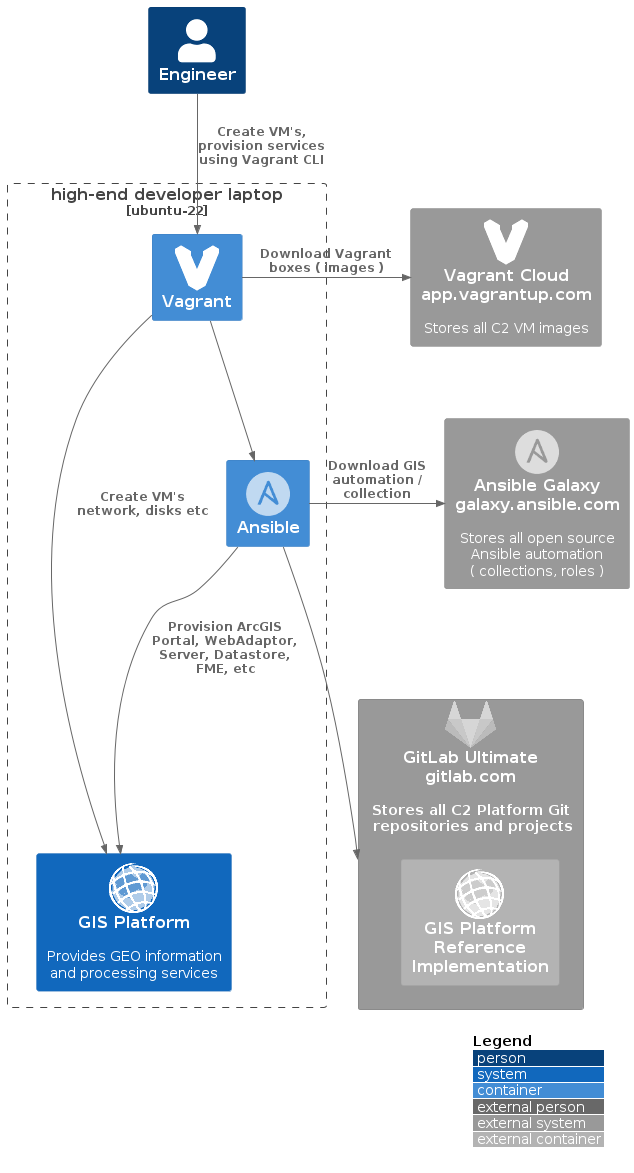Reference Implementations
Categories:
In the realm of system engineering and infrastructure-as-code (IaC), the term “reference implementation” transcends the status of a mere blueprint. It evolves into a fully functional, seamlessly integrated system. This exemplar not only serves as a model but also as a standardized, well-documented exemplar, showcasing how to efficiently deploy and manage a specific system, with Ansible taking center stage.
Ansible, a linchpin of any automation initiatives, plays a pivotal role in this context.
Within the context of the C2 Platform, a reference implementation conjoins two pivotal components: the Ansible Inventory Project and the Vagrant Project. The synergy of Vagrant and Ansible is particularly potent, offering a holistic solution. Vagrant orchestrates the creation of virtual machines, including network configurations and disk allocations, while Ansible takes charge of installing and managing various nodes and virtual machines. For instance, in the case of the GIS Platform, this encompasses deploying components like ArcGIS Enterprise Web Adaptor, Portal, Server, Datastore, FME, and more.
As depicted in the diagram below, the C2 Platform engineer can effortlessly construct complete environments via Vagrant, capitalizing on various cloud services:
- Vagrant Cloud houses C2 images compatible with LXD, VirtualBox, and more.
- GitLab.com serves as the repository for all C2 Projects, offering a myriad of resources.
- Galaxy functions as the repository for open-source automation roles and collections, including those designed for the C2 Platform in the realm of GIS.
This all is made possible through an “open, unless” approach. This approach permits the exploration and test-driving of the GIS Platform, mirroring its deployment at the RWS Data Center, by leveraging its open-source counterpart reference implementation.
In the context of an open-source Ansible project, a reference implementation stands as a prime example project, offering insights into how Ansible Collections and Ansible Roles are configured within an Ansible Inventory Project, often referred to as a playbook project. This configuration equips users to deploy a fully functional system. The reference implementation doesn’t merely serve as an abstract reference but as a practical framework, openly accessible for similar deployments by clients and organizations.
Let’s delve into the core attributes of this concept:
- Comprehensive Implementation: A reference implementation encapsulates the entirety of a functional and integrated system. It meticulously covers all configurations, settings, and interdependencies required for seamless operation. This comprehensiveness assures that the reference implementation mirrors the intended system in entirety.
- Parity with Production: For instance, the GIS Platform Reference Implementation serves as the open-source counterpart to the GIS Platform within Rijkswaterstaat (RWS). This implies that it closely emulates the production environment, ensuring alignment with real-world setups.
- Detailed Documentation and Best Practices: Similar to conventional reference implementations, a complete reference implementation features extensive documentation. This documentation elucidates the system’s purpose, configurations, best practices, and management guidelines. It stands as an invaluable resource for team members involved in deploying and maintaining the system.
- Training and Consistency: The reference implementation also serves as a vital resource for training and learning, aiding team members in grasping how to efficiently deploy and manage the entire system. Additionally, it enforces consistency within your infrastructure, mitigating the risk of errors or misconfigurations.
In the context of Ansible and Vagrant, a comprehensive reference implementation may encompass Ansible playbooks for system configuration and management, along with Vagrantfiles delineating the VM infrastructure. These resources are thoroughly documented and rigorously tested to ensure they faithfully represent the target system.
To sum up, a reference implementation is not a mere sketch but a fully functional, fully integrated system. It guarantees efficient and consistent management of infrastructure components while aligning with the reality of production environments. This is particularly significant in scenarios like the GIS Platform Reference Implementation, where it aims to replicate an existing system within organizations such as Rijkswaterstaat (RWS).
The purpose of the reference implementation extends to elucidating how software can be employed and configured, serving as a launching pad for customizing and configuring software to meet specific requirements. By leveraging open-source building blocks, like Ansible roles, organizations can leverage the work of others, expediting software development and implementation. This promotes uniformity in deployments and fosters collaborative efforts among organizations employing the same software.
An exemplar of a reference implementation is the
ansible-gis
configuration and playbook project for the Rijkswaterstaat GIS Platform. This
project facilitates the local deployment of a comprehensive, functional
environment for the Rijkswaterstaat GIS Platform. To accomplish this, the
project leverages Ansible collections such as
c2platform.gis
and
c2platform.wincore.
Feedback
Was this page helpful?
Glad to hear it! Please tell us how we can improve.
Sorry to hear that. Please tell us how we can improve.